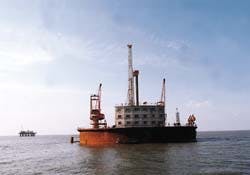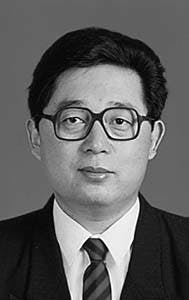Man-made Island Exploits Shallow Water Offshore China
Lu Jichen
Offshore Engineering Co.
Tiajin, China
An oil field in a shallow water area of Bohai Bay, offshore China, will be developed from a man-made island (Fig. 1).
A man-made island was selected for exploiting oil in a shallow water area in the Bohai Bay, offshore China.
The island (Fig. 1) was built with a double-walled steel caisson that was air-lifted to its location during 1992. Three exploration wells were drilled from the island, and now the Dagang field operators (Dagang Oilfield Group Ltd. Co.) plan to begin drilling production wells from the island once development plans are finalized.
Bohai Bay
In eastern China, one main oil producing area contains the Shengli, Liaohe, and Dagang oil fields, next to Bohai Bay. The Bohai Petroleum Corp. is charged with offshore exploration and development in the bay.
Because of difficult environmental conditions, the shallow water area in the western part of the bay has been developed slowly. This area has river silt that is close to 19-m thick. The silt flows like plastic and has no load capacity. The seabed is smooth, with a slope of 0.5-10% and is void of natural and artificial channels.
During winter, an ice dike is easily built to a 1 to 3-m height and 2-km width. Fishing is a main activity during the remainder of the year.
Because of these conditions, no conventional drilling rig can be used in the area, and dredging would be a high-risk, high-cost endeavor.
Area geology
Detailed 2D and 3D seismic surveys indicate that the geological structures offshore are extensions of the onshore Shengli and Dagang oil fields. The area contains a complex of structures. Estimated oil reserves are considerable.
Dagang oil field operators have been investigating the area since the 1970s. Problems that had to be overcome before development of the area could proceed include:
- Providing access to the area
- Working with difficult conditions such as high tides and frequent storms.
After experiments and research in the Dagang oil field, a feasibility report concluded that the best solution was a man-made island.
Island design
During the last half of 1991, the steel part of the island was prefabricated on land. Seal, strength, integral air lifting, and towing tests were carried out in early 1992.
The steel caisson was towed out to sea on May 21, 1992, and set on a 36 concrete-pile foundation. Concrete was cast into the caisson to form the island walls. The double-walled steel plate caisson is ring strapped.
The steel caisson was lifted from the ground by an air-cushioned system that used special aprons and air-blowers. The caisson was towed over the beach and amphibious areas.
The steel caisson has a 63.6 m OD and 60 m ID. The wave height wall is 11.5 m. The upper working level is at 9.8 m and the bottom level is at 5.5 m. The height of the steel unit prefabricated onshore was 8 m, and its total weight, including some of the air-cushion equipment, was 685 tons.
Design considerations
To make the island more suitable for the actual environment, technical personnel spent 1 year investigating the weather and sea conditions at the offshore location. They also conducted a detailed survey of the sea bottom geology.
The island was designed for a 50-year storm. Designed service life of the island is 20 years.
The steel body was prefabricated in 36 pieces in a factory before being moved to the construction site for assembly. All the steel portions were examined according to the "Survey Standard" of the China Classification Society. Air-tight tests were also conducted.
Also installed at the construction site was an air-lifting system, electrical system, weight balancing system, and recording instruments.
More than 40 air-lifting tests were carried out over 2 months. After several alterations, the steel unit, weighing 685 tons, was smoothly air-lifted from ground by about 800 mm.
Field installation
A Hovercraft equipped with a capstan was selected for towing. The steel unit was positioned at the location with a "four point" and "two line" method. The final location differed by only 2 m from the design.
The load test of the concrete pile casting was conducted on land before moving the piles to the location.
A continuous concrete-casting method was used for the walls. This method resulted in high quality and shortened construction time.
From the time the island steel unit was positioned, the settling stability was monitored and the load readjusted continually to avoid having the island set on an incline.
The settling data indicated that the island would be stable. After calculations and analyses, specialists concluded that the island wall and 36 supporting piles could be connected.
The island construction was basically completed by June 1993.
Drilling
Drilling equipment began being installed on the island in July 1993. The equipment consisted of upper and lower working levels. The lower level contained:
- Mud pump
- High-pressure mud circulating system
- Water supply system
- Waste water and water disposal systems
- Fire fighting and monitoring system
- Measuring system
- Material storage.
- Drilling rig and derrick
- Well-control system
- Solid control and surface circulating system
- Power supply and power control system
- Living quarters
- Life-saving equipment
- Communications equipment
- Cementing, logging, well-testing systems, and lifting equipment.
The island can accommodate two rigs. Two drilling slots are on the island, and 30 wells can be drilled from each slot.
The first well, a vertical well ZC-1, was spudded from the island on Aug. 26, 1993.
During drilling, all materials were transported to the island from shore by fishing boat during high tide and by a special barge and a 35-ton, air-cushioned craft during low tide.
These vessels also served the island as standby vessels for safety.
Sump oil and waste water were discharged to the sea after being treated, and the solid waste materials were transported back to land for disposal.
Through 1995, three wells were drilled from this island. Two are directional wells having a large displacement. Both flowed oil during testing.
The drilling costs of the wells were about 30-50% less than those of Apache China Corp. and Bohai Petroleum Co., operating in adjacent offshore areas from drilling platforms.
The operations of the island prove that this method is reliable and economic for exploiting oil and gas in the very shallow water area of western Bohai Bay. Other similar areas in the world may also benefit from this type of development.
BOOKS
The Demand for Oil Products in Developing Countries, by Dermot Gately and Shane S. Streifel. Published by World Bank Publications, P.O. Box 7247-8619, Philadelphia, Pa. 19170-8619. 88 pp., $8.95.
Here is an analysis of the demands for petroleum products in the world's lesser-developed areas.
The Legend of Halliburton, by Jeffrey L. Rodengen. Published by Write Stuff Syndicate Inc., 1515 Southeast 4th Ave., Fort Lauderdale, Fla. 33316. 208 pp., $39.95.
Here is the story of how two companies, Brown & Root and Halliburton, were formed and grew into leaders in their respective fields. It describes the unique corporate entity that has grown as a result of their joining together in December 1962.
Earle Halliburton revolutionized oil production with innovative oil well servicing methods. Brown & Root began when Herman Brown accepted several trace-worn mules as payment from a former employer.
Using interviews, press clippings, and lots of b&w and color photos, this coffee table-style book gives a great look at how Halliburton grew into an industrial giant.
Lu Jichen is a senior engineer with Offshore Engineering Co., Dagang Oilfield Group Ltd., in China. He has worked in drilling for the last 15 years. He also was involved in construction of the man-made island and in drilling of three exploration wells from the island.Lu Jichen has a BS from East China Petroleum Institute.
Copyright 1997 Oil & Gas Journal. All Rights Reserved.


